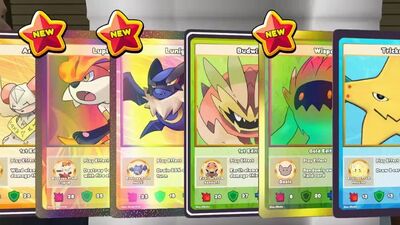Quick facts:Card Pricing Strategies
Card Pricing Strategies in TCG Card Shop Simulator are crucial for running a profitable card shop while maintaining customer satisfaction and attracting a diverse clientele. Effective pricing ensures that both common and rare cards contribute to the shop’s revenue.
Factors Influencing Card Pricing[edit | edit source]
Several factors affect how players should price their cards:
- Rarity: Higher rarity cards, such as Legendary or Ghost, command premium prices due to their scarcity.
- Demand: Cards tied to popular decks or in high demand by customers should be priced higher.
- Market Trends: Use the TCG Price app to track daily price fluctuations and adjust prices accordingly.
- Shop Reputation: A higher shop reputation allows for slightly higher pricing without negatively impacting customer satisfaction.
Pricing Methods[edit | edit source]
Below are common strategies to set card prices effectively:
Standard Pricing[edit | edit source]
Set prices based on card rarity and market trends:
- Common Cards: Priced affordably to attract new players and casual buyers.
- Rare/Epic Cards: Mid-range pricing that balances profit with accessibility for collectors.
- Legendary/Ghost Cards: High pricing to reflect their rarity and collectible value.
Event-Based Pricing[edit | edit source]
Adjust card prices based on ongoing in-game events:
- Cards tied to event themes (e.g., elemental tournaments) can be priced higher due to increased demand.
- Avoid overpricing non-event cards during such periods to maintain customer satisfaction.
Competitive Pricing[edit | edit source]
Monitor competitor shops or customer reviews to ensure pricing aligns with market expectations:
- Slightly undercut competitors for common and rare cards to increase traffic.
- Offer exclusive cards, such as Ghost editions, at competitive but premium rates.
Bulk Discounts[edit | edit source]
Offer discounts on bulk purchases to encourage customers to buy multiple cards:
- Set a fixed discount percentage (e.g., 10% off for three or more cards).
- Highlight bulk discounts in the shop to attract collectors and players building decks.
Tools for Effective Pricing[edit | edit source]
Several tools and methods can aid in optimizing card prices:
- TCG Price App: Monitors daily price trends and provides recommendations for adjustments.
- Market Analysis: Observe which cards sell quickly and adjust prices accordingly.
- Customer Feedback: Use the in-game Reviews app to identify pricing complaints and make necessary changes.
Benefits of Optimized Pricing[edit | edit source]
Implementing effective card pricing strategies offers several advantages:
- Increased Revenue: Maximizes profits by aligning prices with market demand and rarity.
- Improved Reputation: Satisfied customers are more likely to return and recommend the shop.
- Inventory Management: Encourages the sale of slow-moving stock through discounts or adjusted pricing.
Conclusion[edit | edit source]
Mastering card pricing strategies is essential for players aiming to create a thriving business in TCG Card Shop Simulator. By balancing rarity, demand, and customer satisfaction, players can maximize their profits and establish a successful shop.
